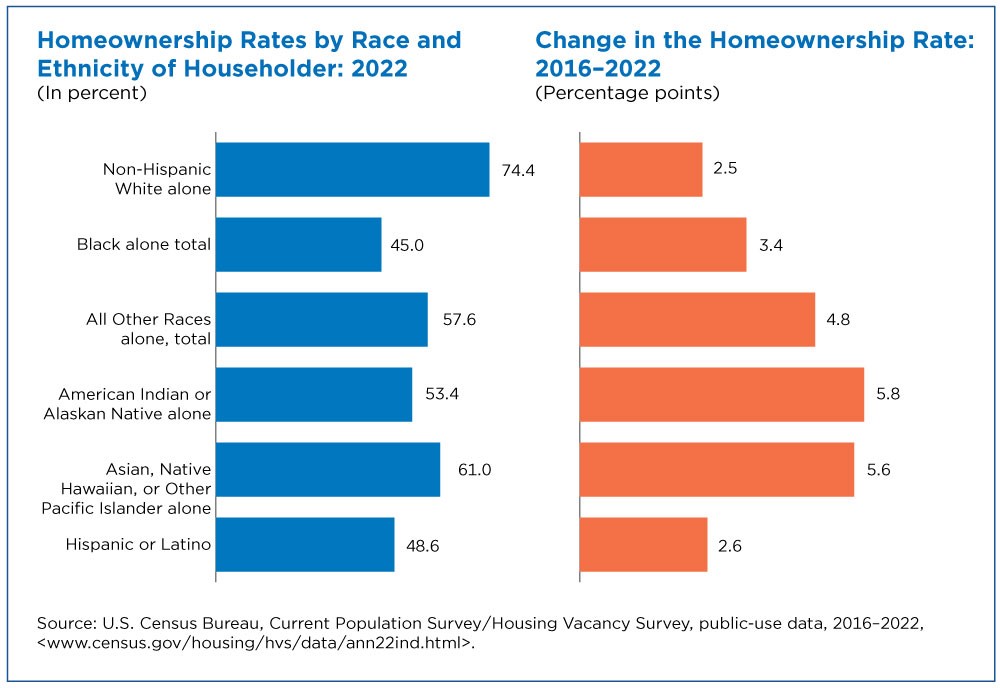Rate of Homeownership Higher Than Before Pandemic in All Regions
The U.S. homeownership rate in 2022 was even higher than before the COVID-19 pandemic — 65.8% compared to 64.6% in 2019 — a rebound driven largely by those age 44 and younger, according to the Census Bureau’s Current Population Survey/Housing Vacancy Survey (CPS/HVS).
Homeownership continued to climb from the downturn following the foreclosure crisis (2004) and Great Recession (2008), when rates dipped as low as 63.4% in 2016. Homeownership rates recovered approximately half of the 5.6% decrease from 2004 to 2016.
The recovery began before the pandemic hit the United States in March 2020: rates rose 1.2 points from 2016 to 2019, and by another 1.2 points from 2019 to 2022.
Younger households typically are more likely to rent than own homes. Yet from 2016 to 2022, homeownership among adults under age 55 went up but remained stable among older populations.
The pandemic disrupted CPS/HVS data collection operations in 2020 and part of 2021. As a result, it is difficult to know whether the homeownership rate grew during each year of the pandemic.
To account for the disruption, this article focuses on homeownership rate changes from the low in 2016; the 2019 pre-pandemic rate; and the rate in 2022 (when data collection returned to normal).
Younger Householders Fueled Homeownership Increase
Younger households typically are more likely to rent than own homes. Yet from 2016 to 2022, homeownership among adults under age 55 went up but remained stable among older populations.
From 2016 to 2019, homeownership increased among householders under age 35 (up 2.2 percentage points), ages 35 to 44 (up 1.5 points), and 45 to 54 (up 0.8 points). The increases for the 35 to 44 age group were not statistically different from the youngest and the oldest age groups.
Rates among older householders were not statistically different during the same period.
The pattern was similar from 2019 to 2022 when homeownership rates also rose about 2% among householders under age 35 and between ages 35 and 44, with one exception: the rate also inched up (0.5 percentage points) among those age 65 and over. There was no statistically significant change among householders in other age groups.
Homeownership Increased in All Regions
Homeownership rates rose in the Northeast, South and West from 2016 to 2019, and in all regions from 2019 to 2022.
Low mortgage rates likely helped drive the rise, even after rates began to go up in 2022.
By 2022, the homeownership rate in the Midwest hit 70%, the highest of all regions. The South had the second-highest homeownership rate (67.3%), followed by two regions that were not statistically different: the Northeast (62.5%) and West (61.4%).
Homeownership Increased Among All Racial/Ethnic Groups
Homeownership rates rose from 2016 to 2019 among non-Hispanic White householders, Asian, and Native Hawaiian, or Other Pacific Islander householders. There was no increase among Black or American Indian/Alaskan Native householders.
But from 2019 to 2022, homeownership rates increased among householders of all races and ethnicities except for American Indian or Alaskan Native householders.
The share of non-Hispanic White householders who owned a home grew from 71.9% in 2016 to 74.4% in 2022. There was about a 3-point increase for Black alone householders (45%) and about a 6-point increase for American Indian or Alaska Native householders (53.4%) and Asian, Native Hawaiian, or Other Pacific Islander householders (61.0%).
There was no significant difference in the increases for non-Hispanic white householders compared to Black alone, American Indian or Alaska Native, or Hispanic householders.
The difference was also not significant for Black householders compared to American Indian or Alaska Native or Hispanic householders, or for American Indian or Alaska Native versus Asian, Native Hawaiian, or Other Pacific Islander or Hispanic householders.
About the CPS/HVS
Each annual CPS/HVS release includes more detailed information about homeownership rates by region, age of householder, and race/ethnicity of householder. It also includes overall homeownership estimates for the 50 states and the District of Columbia and the 75 largest metropolitan statistical areas.
In addition, it provides characteristics of vacant housing units for rent and for sale at the national and regional levels, as well as rental and homeowner vacancy rates.
More information on confidentiality protection, methodology, sampling and nonsampling error, and definitions is available in this document.
Related Statistics
Subscribe
Our email newsletter is sent out on the day we publish a story. Get an alert directly in your inbox to read, share and blog about our newest stories.
Contact our Public Information Office for media inquiries or interviews.
-
America Counts StorySee a Vacant Home? It May Not be For Sale or RentMay 25, 2023The largest category of vacant housing is seasonal housing, from beachfront homes to part-time residences.
-
America Counts StoryHousing Costs a Big Burden on Renters in Largest U.S. CountiesDecember 08, 2022New U.S. Census Bureau data show that renters are more likely than homeowners to spend more than 30% of their income on housing costs.
-
America Counts StoryHow Long Does It Take Renters to Find a Place?May 17, 2023The 2021 American Housing Survey shows that 58.5% of renters who moved between 2019 and 2021 found a new place to live in less than a month.
-
Income and PovertyNew Snapshots From the Survey of Income and Program ParticipationApril 21, 2025New Census Bureau product offers mobile-friendly fact sheets on who receives income from various sources.
-
PopulationU.S. Metro Areas Experienced Population Growth Between 2023 and 2024April 17, 2025New Census Bureau population estimates show 88% of U.S. metro areas gained population between 2023 and 2024.
-
Business and EconomyWhat Is the Nonemployer Marine Economy?April 09, 2025Thirty states had nonemployer businesses in marine economy sectors, including six states in the Midwest with receipts totaling nearly $11 billion in 2022.
-
Business and EconomyEconomic Census Geographic Area Statistics Data Now AvailableApril 07, 2025A new data visualization based on the 2022 Economic Census shows the changing business landscape of 19 economic sectors across the United States.









